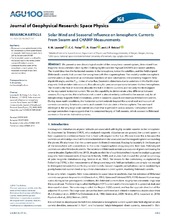| dc.contributor.author | Laundal, Karl Magnus | |
| dc.contributor.author | Finlay, Christopher C. | |
| dc.contributor.author | Olsen, N | |
| dc.contributor.author | Reistad, Jone Peter | |
| dc.date.accessioned | 2019-07-05T13:40:30Z | |
| dc.date.available | 2019-07-05T13:40:30Z | |
| dc.date.issued | 2018-05-29 | |
| dc.Published | Laundal KM, Finlay CC, Olsen N, Reistad JP. Solar Wind and Seasonal Influence on Ionospheric Currents From Swarm and CHAMP Measurements. Journal of Geophysical Research - Space Physics. 2018;123(5):4402-4429 | eng |
| dc.identifier.issn | 2169-9402 | en_US |
| dc.identifier.issn | 2169-9380 | en_US |
| dc.identifier.uri | https://hdl.handle.net/1956/20570 | |
| dc.description.abstract | We present a new climatological model of the ionospheric current system, determined from magnetic measurements taken by the Challenging Minisatellite Payload (CHAMP) and Swarm satellites. The model describes the horizontal currents in the ionosphere, below the satellites, and the field-aligned (Birkeland) currents that connect the ionosphere with the magnetosphere. The model provides ionospheric current values at any location as continuous functions of solar wind speed, interplanetary magnetic field, dipole tilt angle, and the F10.7 index of solar flux. Geometric distortions due to variations in the Earth’s main magnetic field are taken into account, thus allowing for precise comparisons between the two hemispheres. The model is the first of its kind to describe the full 3-D electric currents and not only the field-aligned or the equivalent horizontal current. We use this capability to demonstrate a key difference between seasons: During winter, the total horizontal current is almost entirely confined to the auroral oval, for all interplanetary magnetic field orientations, where it connects upward and downward Birkeland currents. During more sunlit conditions, the horizontal current extends beyond the auroral oval and is a sum of currents connecting Birkeland currents and currents that circulate in the ionosphere. The westward electrojet is the only large-scale current structure that is persistent across seasons. Comparison with average convection maps suggests that it is comprised largely of Hall currents, which connect to Birkeland currents in the winter but not in summer. | en_US |
| dc.language.iso | eng | eng |
| dc.publisher | American Geophysical Union | en_US |
| dc.rights | Attribution-Non Commercial-No Derivatives CC BY-NC-ND | eng |
| dc.rights.uri | http://creativecommons.org/licenses/by-nc-nd/4.0/ | eng |
| dc.title | Solar Wind and Seasonal Influence on Ionospheric Currents From Swarm and CHAMP Measurements | en_US |
| dc.type | Peer reviewed | |
| dc.type | Journal article | |
| dc.date.updated | 2019-01-24T11:37:16Z | |
| dc.description.version | publishedVersion | en_US |
| dc.rights.holder | Copyright 2018 The Authors | en_US |
| dc.identifier.doi | https://doi.org/10.1029/2018ja025387 | |
| dc.identifier.cristin | 1632375 | |
| dc.source.journal | Journal of Geophysical Research - Space Physics | |

